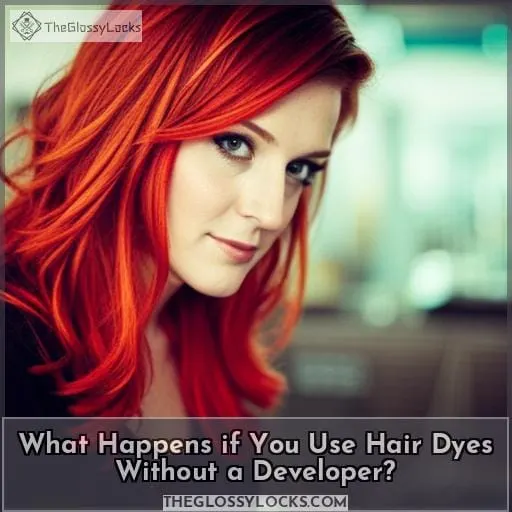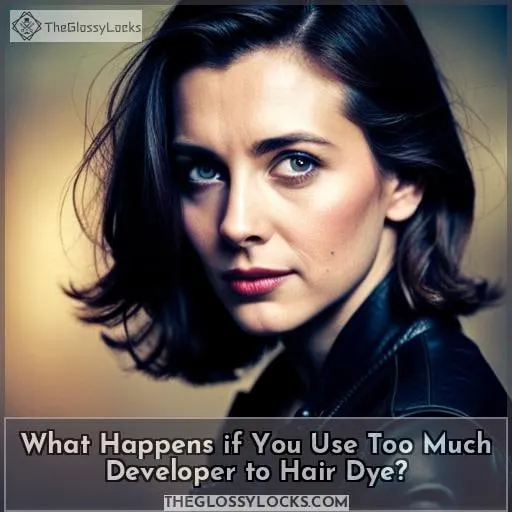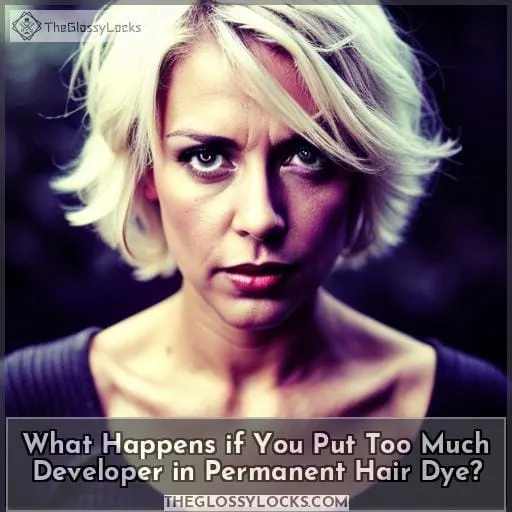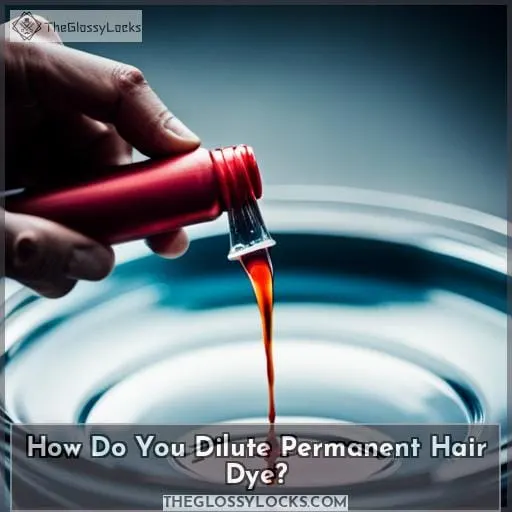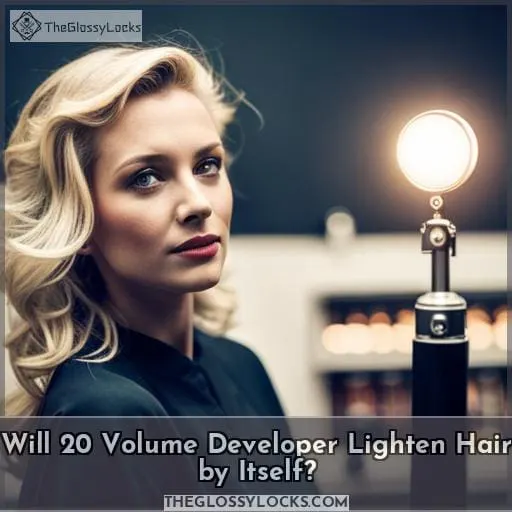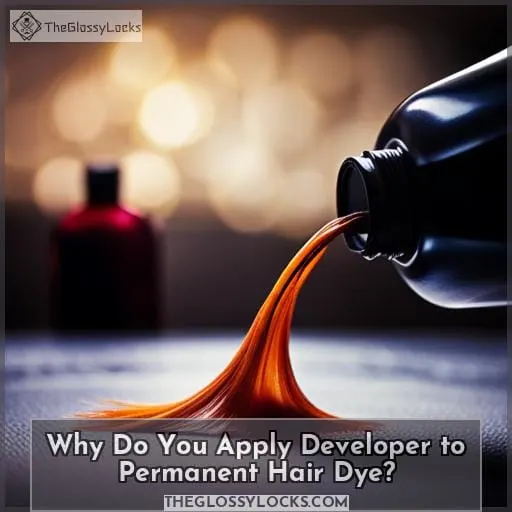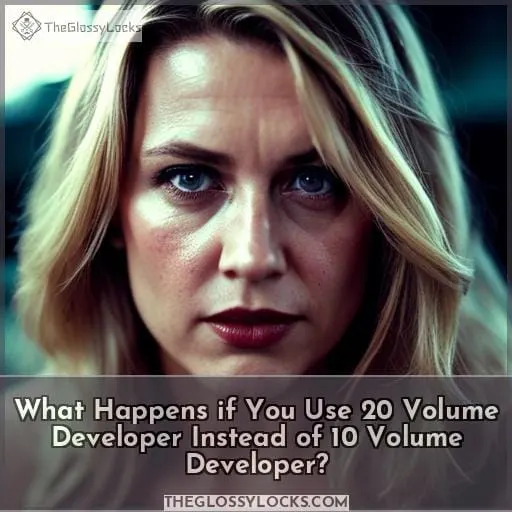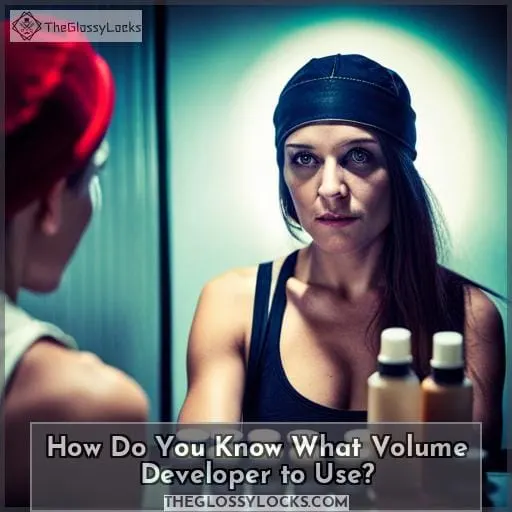This site is supported by our readers. We may earn a commission, at no cost to you, if you purchase through links.
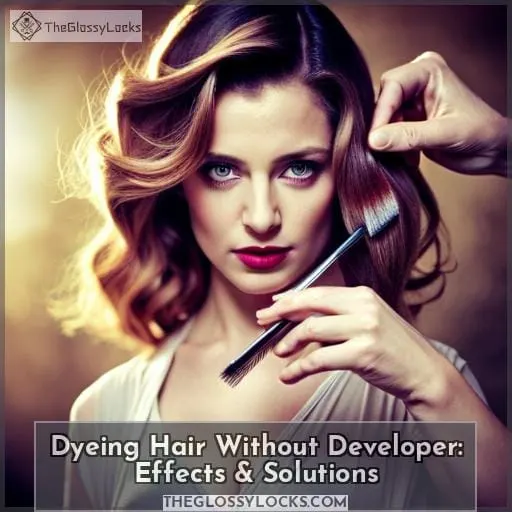 Ready to change up your hair color without the hassle of a developer? Look no further! In this article, we’ll explore the effects and solutions for dyeing hair without developer.
Ready to change up your hair color without the hassle of a developer? Look no further! In this article, we’ll explore the effects and solutions for dyeing hair without developer.
Discover how skipping the developer can result in:
- Undesired or uneven color
- Temporary results
Whether you’re seeking a more natural option or want to avoid potential damage, we’ve got you covered with tips and tricks for achieving beautiful hair color without using a traditional developer.
Table Of Contents
- Key Takeaways
- What Happens if You Use Hair Dyes Without a Developer?
- What Happens if You Use Too Much Developer to Hair Dye?
- What Happens if You Put Too Much Developer in Permanent Hair Dye?
- How Do You Dilute Permanent Hair Dye?
- Will 20 Volume Developer Lighten Hair by Itself?
- Will 10 Volume Developers Damage Hair?
- Why Do You Apply Developer to Permanent Hair Dye?
- What Happens if You Use 20 Volume Developer Instead of 10 Volume Developer?
- What if You Use 30 Volume Developer Instead of 20 Volume Developers?
- How Do You Know What Volume Developer to Use?
- Frequently Asked Questions (FAQs)
- Conclusion
Key Takeaways
- Using hair dyes without developer can result in undesired color, uneven color distribution, and temporary results.
- Using too much developer with hair dye can result in a lighter color, insufficient hair dye deposit, and shorter color duration.
- Diluting permanent hair dye is possible by mixing it with conditioner, but it should only be done with certain types of hair dyes.
- The choice of developer should be based on desired hair color, level of lift or deposit needed, and hair porosity.
What Happens if You Use Hair Dyes Without a Developer?
When you dye your hair without a developer, you risk getting:
- An undesired color
- Uneven color distribution
- Temporary results
The developer activates the color molecules in hair dye, allowing them to penetrate the hair shaft for even, long-lasting color.
Undesired Color
When you use hair dyes without a developer, the color may not turn out the way you want it to. This can result in an uneven, patchy, or muddy color that isn’t vibrant, fades quickly, and simply undesired.
Consider mixing demi-permanent dye with conditioner to dilute the color.
Or try a semi-permanent dye for a more even result without developer.
Uneven Color
If you don’t use a developer, the color may not be evenly distributed throughout your hair.
To avoid this issue, consider using a brown direct dye for more precise application on virgin hair.
Temporary Color
To achieve temporary color,
dyeing your hair without a developer results in color that won’t last as long and may not turn out the way you want it.
Semi-permanent hair dye is a great option for temporary color, but keep in mind that it will gradually fade with each wash.
What Happens if You Use Too Much Developer to Hair Dye?
Using too much developer in hair dye can have several negative effects.
Firstly, the color will appear lighter than desired because there won’t be enough hair dye deposit on the strands.
Additionally, the color won’t last as long since an excess of developer dilutes the pigments and weakens their staying power.
It’s important to follow the recommended mix instructions for permanent hair dye to achieve optimal results and avoid these issues.
Lighter Color
As you use excess developer for hair dye, the result will be a lighter color since there isn’t enough actual dye deposit to deeply saturate the hair.
- It won’t last long
- The color lift will be minimal
- There’s a risk of damage from overprocessing
- Alternatives are semi-permanent dyes
- Always follow instructions carefully
Insufficient Hair Dye Deposit
When mixing too much developer into your permanent hair dye, you’ll end up with insufficient color deposit that won’t provide the vibrant, long-lasting color you’re after.
- Splotchy coloring
- Uneven color distribution
- The color to wash out quickly as it isn’t permanent.
Shorter Color Duration
Using too much developer will result in shorter-lived color that fades quickly.
Opt for just enough to activate dye without over-processing, compromising vibrancy and longevity.
Alternatively, try no-developer semi-permanents or demi-permanents for gentler, safer depositing color, sparing hair damage.
What Happens if You Put Too Much Developer in Permanent Hair Dye?
Transitioning from potential issues with using too much developer, let’s explore what happens when you use too much developer in permanent hair dye.
While it may seem harmless, putting excessive developer in permanent color can have some unintended consequences. Primarily, it will lift and lighten the final shade, giving you a color lighter than expected.
Too much developer also impairs the dye’s longevity – the color simply won’t cling to hair as effectively or last as long.
As the main active ingredient that opens the cuticle for dye penetration, developer is crucial for permanent color. But more isn’t necessarily better. For optimal results, follow mixing instructions and use the recommended developer-to-dye ratio for your hair type and desired color lift.
This prevents over-processing and damage while enabling the dye to properly saturate hair, giving you rich, lasting color.
How Do You Dilute Permanent Hair Dye?
You can dilute permanent hair dye by mixing in conditioners.
This only works with some types of dyes though.
For example, using conditioner on a violet electric blue hair dye will turn it into a soft lavender.
Mixing With Conditioners
You can dilute permanent hair dye by mixing it with conditioners. This works best with certain types of dyes as it will affect color intensity and longevity.
Demi-permanent dyes and color depositing masks will blend well while maintaining vibrancy.
Alternatively, try direct dyes which require no developer and won’t damage hair further when used as a refresher.
Always consider hair porosity and select an appropriate developer strength for even results without excessive lightening.
Suitable Hair Dye Types
When diluting permanent hair dye, stick with dye types that specify dilution is possible, like some semipermanents.
These plant-based dyes are great options for achieving the color you desire without the need for a developer.
Semi-permanent and demi-permanent dyes can be diluted with conditioner to create a softer shade or pastel effect.
Additionally, direct dyes and henna are other suitable options that don’t require a developer for application.
Explore these alternatives to achieve beautiful hair color while maintaining control over your desired look.
Will 20 Volume Developer Lighten Hair by Itself?
When considering whether 20 volume developer will lighten hair by itself, it’s important to understand that the outcome depends on the specific type of developer being used.
Generally, using 20 volume developer alone can provide some lightening effects, especially when compared to lower volumes. However, for significant lightening or bleaching purposes, using a higher strength such as 30 or even 40 volume may be necessary.
It’s crucial to note that any hair-lightening process will inevitably cause damage to your hair.
Dependency on Developer Type
Whether it lightens depends on the developer you pair it with.
Using anything up to 30 volumes by itself should be fine, but if you’re bleaching, you’ll need a 20 or 30 volume developer to lift dark hair and cover grays.
Consider your hair’s condition and type before deciding on developer strength.
Use for Bleaching
However, if you’re bleaching, you’ll need to use 20 or 30 volume developers.
These higher volume developers can lighten hair effectively during the bleaching process.
Keep in mind that hair porosity and the type of developer used will affect the lightening results.
Bleaching always comes with some degree of damage to your hair.
Hair Damage
Using 20 volume developer by itself can cause hair damage.
The strength of the developer and its usage in hair dye application can lead to potential damage, especially when it comes to lightening the hair color.
It’s important to consider factors such as hair porosity and type of developer when mixing for optimal results without compromising the health of your hair.
Will 10 Volume Developers Damage Hair?
Using a 10 volume developer on your hair won’t cause damage. In fact, it can actually help the color take better and result in more vibrant results. However, it’s important to consider your hair porosity when choosing a developer strength to ensure optimal absorption of the dye.
Mild Effect on Hair
You’ll find ten volume developers have a mild effect on hair that won’t cause damage.
These developers are great for enhancing color absorption, especially for those with low hair porosity.
Consider using them with hi-color or brown direct dyes to achieve your desired results without compromising the health of your hair.
Enhanced Color Absorption
You won’t experience any damage to your hair when using 10 volume developers, but it will help the color absorb better.
This is because 10 volume developers enhance color absorption by opening up the hair cuticles and allowing for optimal color deposit. It’s particularly beneficial for individuals with high porosity hair as it helps the dye penetrate deeply into the strands.
Hair Porosity Consideration
How can you determine if using 10 volume developers will damage your hair?
Hair porosity plays a crucial role in determining the effects of using a 10 volume developer. Conducting a porosity test will help you understand how well your hair absorbs color and whether it requires higher or lower volumes of developer for optimal results.
Why Do You Apply Developer to Permanent Hair Dye?
Why must you apply developer to permanent hair dye?
As a licensed cosmetologist, I want to empower you with knowledge about the chemistry behind dyeing hair.
Developer is essential for permanent color; it opens the cuticle layer and activates the dye molecules, allowing them to penetrate into the cortex where they can permanently alter your strands.
Without developer, dye molecules would simply coat the outside of hair temporarily without this catalytic reaction to drive them inside.
Developer is your key to hair rebelling against its natural pigment; wield it to enhance your color with long-lasting intensity.
Don’t shy away from harnessing the power of developer to transform your tresses from drab to fab!
What Happens if You Use 20 Volume Developer Instead of 10 Volume Developer?
You’ll lift more underlying pigment when using a 20 volume developer instead of a 10 volume.
- It will lighten your hair more than a 10 volume, allowing you to achieve a lighter color. However, it also causes more damage by opening up the hair cuticle more aggressively.
- A 20 volume developer has twice the strength of a 10 volume. It lifts your hair 2-3 levels lighter rather than just 1 level with a 10 volume.
When using any developer, it’s crucial to consider your hair’s porosity and condition. More damaged hair won’t tolerate higher volume developers as well. To minimize harm, use the lowest volume possible to achieve your desired shade.
What if You Use 30 Volume Developer Instead of 20 Volume Developers?
Using a 30-volume developer rather than the recommended 20-volume will further lighten your end color. The higher the volume, the more lifting action it provides. While a 30-volume developer will give you faster processing and more lift, it also causes more damage by overly exposing the cuticle.
| Volume | Lifting Action | Processing Time | Damage Level |
|---|---|---|---|
| 10 | Low | Longer | Minimal |
| 20 | Moderate | Moderate | Moderate |
| 30 | High | Faster | More |
| 40 | Very High | Fastest | Most |
Aim for a developer that provides enough lift for your goals without compromising the integrity of your strands. Trust the standard volumes for most applications. When in doubt, consult your colorist. They’ve the expertise to assess your hair and recommend the ideal developer volume.
How Do You Know What Volume Developer to Use?
To determine what volume developer to use, start by considering your desired hair color and the level of lift or deposit you need.
Here are three factors to keep in mind when choosing the right developer strength for your hair:
- Hair porosity: If you have low porosity hair, a lower volume developer may be sufficient as it takes longer for the color to penetrate. On the other hand, high porosity hair may require a higher volume developer for better results.
- Color lift: If you want significant lightening or lifting of your natural color, opt for a higher volume developer like 30 or 40. For subtle changes or depositing darker colors, choose a lower volume like 10 or 20.
- Developer type and brands: Different developers from various brands have varying strengths and formulations. Read product labels carefully and consult with professionals if unsure about which one is suitable for your needs.
Remember that using too strong of a developer can cause damage to your hair while using too weak of one mightn’t give you desired results.
Frequently Asked Questions (FAQs)
What should I do if I get hair dye on my skin or clothes?
If you accidentally get hair dye on your skin or clothes, act quickly.
For skin, use a gentle cleanser or makeup remover to wipe away the dye.
For clothes, pretreat with stain remover and wash as usual.
How long should I leave the hair dye in for maximum color deposit?
For maximum color deposit, leave the hair dye in for 30-45 minutes.
This allows the pigment to fully penetrate and adhere to your strands, resulting in vibrant and long-lasting color that showcases your liberated style.
What happens if you mix different types of permanent hair dye together?
When mixing different types of permanent hair dye together, you run the risk of unpredictable results. The chemical composition and pigments may not interact well, leading to uneven color or undesirable tones.
Can I re-dye my hair the same day if the color comes out uneven?
Re-dyeing your hair the same day to fix uneven color is possible, but proceed with caution.
Evaluate the cause of unevenness first.
If it’s due to improper application or mixing errors, you can reapply.
However, if it’s due to hair damage or over-processing, give your locks time to recover before attempting another dye session for optimal results and hair health.
Conclusion
If you want the color, you must pay the toll—when coloring hair, don’t skip the developer or you’ll end up with faded, uneven results.
Using the proper volume developer ensures vibrant, long-lasting color that penetrates deep into strands.
With some know-how on mixing and application, you can achieve beautiful, healthy hair color and shine by responsibly using developer paired with the dye.

